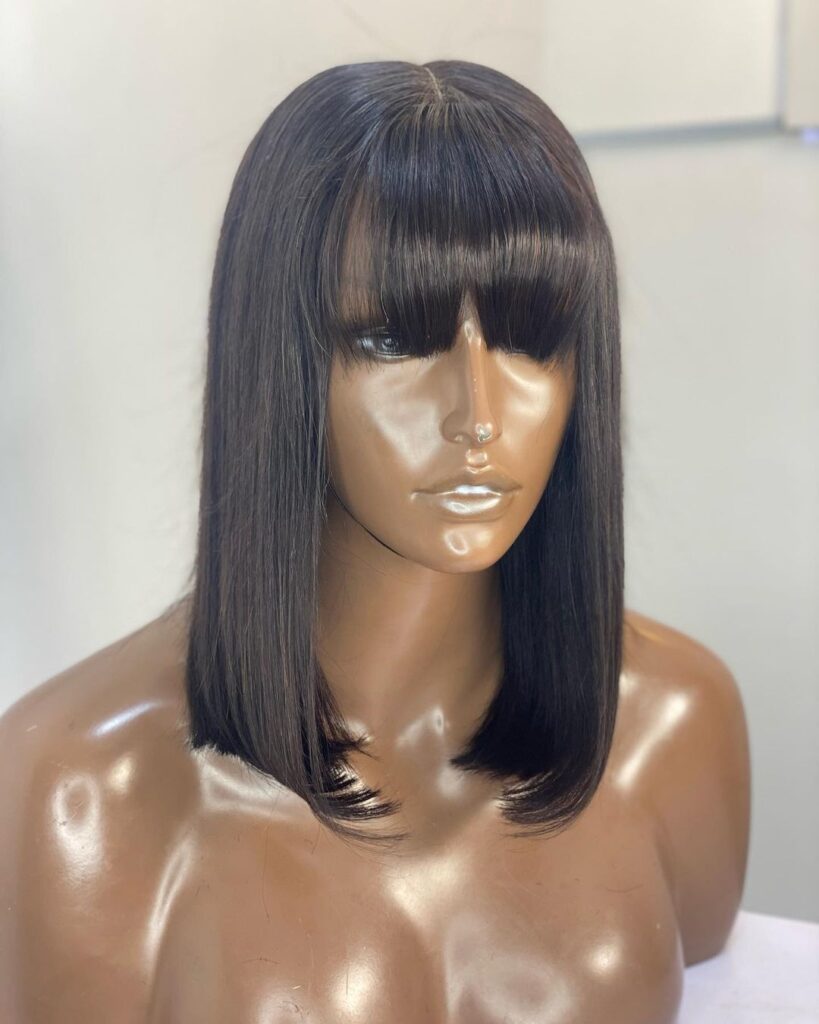Instagram: @nickiminaj
The beauty business is experiencing a big wig boom. For celebrities who frequently attend events and want to swiftly switch up their hairdo without harming their own hair, they have long been a go-to option. But beyond of the world of celebrities (and possibly your aunts), wigs have gained significant traction on social media, where talented hairstylists demonstrate their magic for the general public. It seems like a hairdresser makes the news every other day for perfectly blending a unit to the point that the client’s hair could pass for their own.

Additionally, there are a variety of wig types to choose from, just as there are a variety of wig styling techniques. You have options, baby, including frontals, full-lace wigs, and synthetic units. Wigs are a really flexible and practical choice to take into consideration, whether you’re a naturalista who wants to switch things up without stressing your strands or you’re just seeking for a change without the commitment.
Natural vs. Synthetic
The cost of wigs can add up. Depending on who is making it and what kind of hair is being used, a good human hair wig can cost anywhere from $400 and $5,000. Fortunately, there are high-quality synthetic wigs that are far less expensive—they can even be found for under $100—though they are quite unusual and difficult to find. Having said that, synthetic wigs frequently only last a few months, or even less if you wear them frequently. However, you can use human hair wigs for a few years if you take good care of them.
Types of Wigs
Ready-Made Wigs
These are conveniently offered by neighborhood hairdressers and beauty supply shops. They are one-size-fits-all prestyled designs that can be customized to the wearer’s head and are frequently synthetic and prestyled. They typically cost between $20 and $400, but from my experience, $150 is the average, making them affordable for those of us with limited discretionary income.
Lace-Front Wigs
These are typically made of human hair with a frontal component that can only be divided one or two ways and a closure (a hairpiece that simulates your natural scalp) sewn on the unit’s crown. The back of the device is then sewn using tracks from ear to ear. Costs vary between $100 and $500.
Full-Lace Wigs
A full-lace wig is a ventilated unit that offers mobility [and] allows you to part your hair in any direction. It is often manufactured with human hair and is created with a lace cap. With full-lace wigs, you have countless styling possibilities, regardless of whether you prefer ponytails or cornrows. They are put on by first braiding one’s own hair into cornrows—typically straight back—bonding the wig to the glue, fixing it with wig clips (if any are provided), and then putting on your own hair. Depending on quality, the price of a full-lace wig ranges from $200 to $5,000.
Custom Wigs
These human-hair wigs were made particularly with the wearer’s head circumference and preferred style in mind, as the name implies. A hair stylist makes a base for a custom wig that is fitted to your head (often made of lace or a stocking cap with a stretchy, predetermined band attached), after which the hair of your choice is sewn on. They can cost more than $200 and are offered as lace-front or full-lace wigs.
Wig Maintenance
Like with hair extensions, they should be maintained in the same manner as your original hair. In the case of wigs in particular, there are a few crucial measures to make in order to increase the lifespan of your product. Every night, wigs and custom accessories should be removed and stored on a mannequin head. Wearing a silk cap or scarf at night, however, will protect the hair and maintain it in great shape if your wig is stitched along your hairline (the same goes for full-lace wigs that have been applied with an adhesive).
Use shampoo and conditioner without sulfates to clean your wig(s).
Because wigs lack a natural source of moisture, you should refrain from cleaning them with products that contain harsh detergents. While your own hair benefits from the oils produced by your scalp, wigs don’t. Here are some uses for sulfate-free shampoo and conditioner: You won’t harm the hair’s integrity with them because they are gentle cleaners.
Avoid over-washing them.
Depending on how often you wear your wigs, you should wash them more frequently. If you wear a wig every day, washing it twice a month is plenty to keep the hair looking healthy and bouncy for as long as possible. However, if you just sometimes use a wig, a once-a-month wash will be sufficient. Never wash wigs more than twice in a single month to avoid harming the product and reducing its lifespan.
When not in use, keep all wigs on a mannequin head.
Acquire a mannequin head so you can rest your wig between uses if it isn’t sewn to your head. This also serves as a fantastic technique to maintain the styling of your wig as you get ready for an outing. Before leaving, leave it on the stand and quickly put it on.
Avoid heating up synthetic wigs.
Synthetic wigs often aren’t able to resist heat styling or a lot of manipulation because they aren’t created from real hair. You should never use heat on your hair since it can really melt it. You can use flexi rods and other heatless tools to style your synthetic wig by giving it huge, bouncy curls.
Never use strong oils or styling products
The best course of action is to steer clear of anything that will make the hair appear greasy or leave behind residue that needs to be washed out later because you don’t want to weigh the hair down.
Style Advice
- Heat styling
When heat styling human-hair wigs, the tools and materials you employ are crucial. The last thing you want to do is damage the hair because wigs may be extremely expensive. Generally speaking, you should use professional thermal styling tools (such as flatirons and curling wands), preferably with temperature-control dials so you can regulate the amount of heat being applied to the hair. Always apply a heat protectant before applying heat on human hair, and only after it has dried fully. - Heatless Styling
The endless styling options are one among the things that make wearing wigs so much fun. A simple and universally flattering hairdo is two gigantic plaits taken down. Spray your hair with water or a light leave-in conditioner before braiding it, and then use your fingers or a wide-tooth comb to untangle it and make it lay flat. Typically, this quick process takes around five minutes. You may create huge, stunning beach waves by unraveling the braids once they have dried, which normally takes an hour or two.
The curl pattern may always be changed without straightening a curly unit by placing the hair on various-sized flexi rods or perm rods, according to hairstylist Ro Morgan. Maintaining those curls’ moisture is also always important. “[It’s] amazing for detangling, defining curls, and refreshing hair once it gets attacked by the humidity,” says Ro of Bumble and Bumble’s Bb. Curl collection, which includes the Bb. Curl Pre-Style/Re-Style Primer. - Modifying the curl pattern
Even if a curly wig is comprised of human hair, it is generally not suggested to totally straighten it because you run the risk of permanently altering the texture. However, there are risk-free ways to slightly change your device: Use a wide-tooth comb to gently open each curl as you gently comb the hair section by section from the bottom up if you want more volume. Repeat this process until the entire unit is the desired size.
The use of two-strand twists is another method for growing out hair. Depending on how much hair you have to work with, prepare the hair by spraying liquid leave-in all over it. Then, divide it into 6 to 10 separate sections. After that, while maintaining tension, twist each segment from root to tip. By air-drying the entire piece overnight or blow-drying it, you may set the twists (if you opt for the latter, make sure to wear a bonnet or silk scarf to protect hair and keep the twist in place). As soon as everything is completely dry, use your fingers to untwist each twist, and presto, you have thick, voluminous curls.
If your wig is made of human hair rather than synthetic hair and has looser curls, like Brazilian wavy, you can easily use a flatiron to straighten it. Don’t forget to flatiron in portions and to apply a heat protectant first. - Ways to change straight hair
Creating curls with straight hair is far simpler (and less harmful) than making a curly wig bone-straight. Using a curling iron or curling wand is the easiest technique to curly straight hair. Try using a small-barrel iron for tighter curls; for larger curls, a large-barrel iron is your best buddy. After dividing your hair into several sections, begin winding the hair around the barrel of the wand while holding it face down. Depending on where you want the curl to fall as you get closer to the top and sides, switch up the wand’s direction. Just be careful not to get too close to your face.
After you’ve combed the entire unit, go back over the roots to add more volume. Apply holding spray, then you’re done. - Making the corners and hairline perfect
Hairstylist Tym Wallace advises positioning wigs “a half-inch behind [your] hairline” if your hairline isn’t as thick as you’d like it to be for a more natural appearance. Deryck swears by another technique for deepening the wig’s genuine portion, which is to utilize L’Oréal Paris Magic Root Cover Up. It resembles the shape of hair. It will make the portion more substantial and ensure that images of it are accessible to anyone. Many famous people are currently engaging in it, he claims. It’s also an excellent method for hiding any lace knots by your hairline, which will make your unit look less synthetic and more like it’s emerging from your scalp.
In the end, maintaining properly trimmed margins is the secret to a faultless installation. Your wig should certainly include them, too, if you have long baby hairs. One essential element to creating a perfect illusion is to mimic your own edges. It leaves people in suspense.

